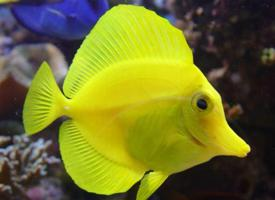
Váhy a míry
| Délka | 18 cm |
|---|
Popis zvířete
The Yellow Tang (Zebrasoma flavescens) is a vibrantly colored saltwater fish, renowned for its striking, bright yellow hue, which covers its body entirely, save for its white spine. A member of the family Acanthuridae, it is native to the Pacific Ocean, with a distribution range that spans from Hawaii to Japan and south to the Great Barrier Reef. This species is particularly prominent in Hawaiian waters, where it is also known by the name "lau'ipala."Adult Yellow Tangs typically measure between 15 to 20 centimeters (6 to 8 inches) in length, showcasing a laterally compressed, oval-shaped body that is characteristic of the surgeonfish family. Their snouts are slightly protruded, aiding in their grazing habits. A distinctive feature of the Yellow Tang, as with other members of the Acanthuridae family, is the presence of a sharp, retractable spine located on either side of the caudal peduncle, which can be used defensively against predators. This spine has earned the fish within this family the nickname "surgeonfish."
The diet of the Yellow Tang is primarily herbivorous. They are voracious grazers, feeding on a variety of algae found on coral reefs and rocky substrates. This feeding behavior not only sustains the Yellow Tang but also plays a crucial role in maintaining the health of coral reefs by preventing algae from overgrowing and suffocating corals.
Yellow Tangs are diurnal, meaning they are active during the day and retreat to crevices in the reef to rest at night. They are generally solitary but can be found in loose aggregations while feeding or during breeding periods. The reproduction of Yellow Tangs involves a fascinating display where females release eggs into the water column to be fertilized externally by males. The eggs are pelagic, drifting with ocean currents until hatching into larval fish, which eventually settle on a suitable reef.
In the aquarium trade, the Yellow Tang is among the most popular marine aquarium fish, prized for its vivid color and relatively peaceful demeanor. However, their popularity has led to concerns over sustainable collection practices. Efforts are being made to breed Yellow Tangs in captivity to reduce pressure on wild populations.
The conservation status of the Yellow Tang is currently listed as Least Concern by the International Union for Conservation of Nature (IUCN), thanks in part to their wide distribution and large populations, especially in protected areas. However, habitat degradation, overcollection for the aquarium trade, and climate change-related impacts on coral reefs pose ongoing threats to their natural habitats.
In summary, the Yellow Tang is not only a beautiful sight for divers and aquarium enthusiasts but also an integral component of its marine ecosystem, contributing to the health and balance of coral reef communities through its grazing habits. Its vibrant color, interesting behaviors, and ecological importance make the Yellow Tang a fascinating subject of study and admiration.
Nové fotografie zvířat
Top 10 zvířat
- Chinese water dragon (Physignathus cocincinus)
- Galápagos tortoise (Geochelone nigra complex)
- Dolphin gull (Leucophaeus scoresbii)
- Japanese macaque (Macaca fuscata)
- Colombian red howler (Alouatta seniculus)
- Sea urchins (Echinoidea)
- Moustached guenon (Cercopithecus cephus)
- Diana monkey (Cercopithecus diana)
- Common reed warbler (Acrocephalus scirpaceus)
- Common house mosquito (Culex pipiens)